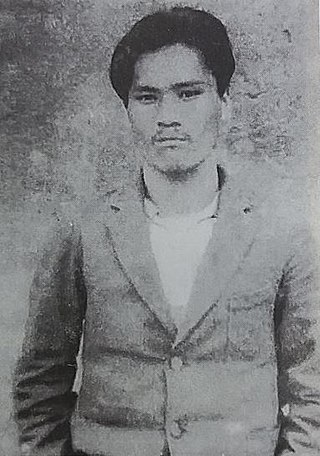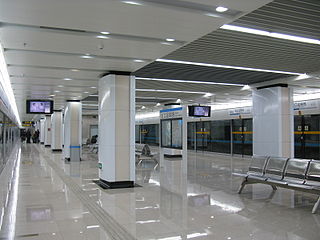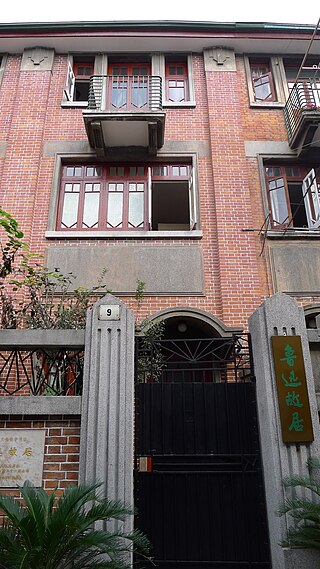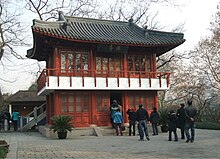
, formerly spelled Hongkew, is a district of Shanghai, forming part of the northern urban core. It has a land area of 23.48 km2 (9.07 sq mi) and a population of 852,476 as of 2010.

Yun Bong-gil was a Korean independence activist. His art name is Maeheon (매헌).

The January 28 incident or Shanghai incident was a conflict between the Republic of China and the Empire of Japan. It took place in the Shanghai International Settlement which was under international control. Japanese army officers, defying higher authorities, had provoked anti-Japanese demonstrations in the International Settlement following the Japanese invasion of Manchuria. The Japanese government sent a sect of militant ultranationalist Japanese Buddhist priests belonging to the Nichiren sect to Shanghai. The monks shouted anti-Chinese, pro-Japanese nationalist slogans in Shanghai, promoting Japanese rule over East Asia. In response, a Chinese mob formed killing one monk and injuring two. In response, the Japanese in Shanghai rioted and burned down a factory, killing two Chinese. Heavy fighting broke out, and China appealed with no success to the League of Nations. A truce was finally reached on May 5, calling for Japanese military withdrawal, and an end to Chinese boycotts of Japanese products.

Hongkou Football Stadium is an interchange station between Lines 3 and 8 on the Shanghai Metro. The station opened on 26 December 2000 as part of the initial section of Line 3 from Shanghai South Railway Station to Jiangwan Town; the interchange with Line 8 opened on 29 December 2007 as part of that line's initial section from Shiguang Road to Yaohua Road.

The history of Shanghai spans over a thousand years and closely parallels the development of modern China. Originally a small agricultural village, Shanghai developed during the late Qing dynasty (1644–1912) as one of China's principal trading ports. Although nominally part of China, in practice foreign diplomats controlled the city under the policy of extraterritoriality. Since the economic reforms of the early 1990s the city has burgeoned to become one of Asia's major financial centers and the world's busiest container port.

Yoshinori Shirakawa was a general in the Imperial Japanese Army. He died from injuries caused by a bomb set by Korean independence activist Yun Bong-gil in Shanghai.

The Shanghai Municipal Police was the police force of the Shanghai Municipal Council which governed the Shanghai International Settlement between 1854 and 1943, when the settlement was retroceded to Chinese control.
Duolun Road, formerly Darroch Road, is a historic street in Hongkou District, Shanghai, China.

North Sichuan Road is a shopping street in Hongkou District, Shanghai, China. From the Suzhou Creek in the south, the road crosses North Suzhou Road, Haining Road, and Hengbang Road among others, and connects with Shanyin Road in the north, giving the road an "S" shape. It joins Duolun Road, and runs to East Jiangwan Road then turns to the west, ending at Lu Xun Park.

The Sakuradamon incident was an unsuccessful assassination attempt against Japanese Emperor Hirohito on January 8, 1932, at the gate Sakuradamon in Tokyo, Empire of Japan.

Yangjae Citizen's Forest (Korean: 양재시민의숲) is a park in Seocho District, Seoul, South Korea. The park's official name is now Maeheon Citizen's Forest, which it adopted in October 2022.

Kanzō Uchiyama was the proprietor of the Uchiyama Bookstore, whose frequent visitors were both Chinese and Japanese intellectuals before World War II. Uchiyama was a Christian.

The Shanghai Jewish Refugees Museum is a museum commemorating the Jewish refugees who lived in Shanghai during World War II after fleeing Europe to escape the Holocaust. It is located at the former Ohel Moshe or Moishe Synagogue, in the Tilanqiao Historic Area of Hongkou district, Shanghai, China. The museum features documents, photographs, films, and personal items documenting the lives of some of the more than 20,000 Jewish residents of the Restricted Sector for Stateless Refugees, better known as the Shanghai Ghetto, during the Japanese occupation of Shanghai.

The Ohel Rachel Synagogue is a Sephardi synagogue in Shanghai, China. Built by Sir Jacob Elias Sassoon in memory of his wife Rachel, it was completed in 1920 and consecrated in 1921. Ohel Rachel is the largest synagogue in the Far East, and one of the only two still standing in Shanghai. Repurposed first under the Japanese occupation during World War II and again following the Communist conquest of Shanghai in 1949, the synagogue has been a protected architectural landmark of the city since 1994. It was reopened for some Jewish holidays from 1999 and briefly held more regular Shabbat services as part of the 2010 Shanghai Expo.

The Beth Aharon Synagogue was a Sephardi synagogue in Shanghai, China, built in 1927 by the prominent businessman Silas Aaron Hardoon in memory of his father Aaron. During World War II, the synagogue provided refuge for the Mirrer yeshiva of Poland, the only Eastern European yeshiva to survive the Holocaust intact. After the establishment of the People's Republic of China, it was used by the Wenhui Bao newspaper and as a factory during the Cultural Revolution. It was demolished in 1985.
The Korean Patriotic Organization (Korean: 한인애국단) was a militant organization under the Korean Provisional Government (KPG) and founded in Shanghai, China in 1931. It aimed to assassinate military and government leaders of the Empire of Japan. The group also went by the name Ŭisaenggun.
Empire Made Me: An Englishman Adrift in Shanghai is the 2003 biography of the Shanghai policeman Richard Maurice Tinkler by the British historian Robert Bickers. Tinkler, a British veteran of World War One turned policeman in interwar Shanghai, was described by Bickers as an extremely tough, able, violent and racist policeman operating in one of the world's most crime-ridden and dangerous cities; who loathed the Chinese as a people and treated them with much brutality. Tinker worked in the Shanghai Municipal Police, the police force of the International Settlement, the district of Shanghai jointly administered by Great Britain and the United States. The New Zealand author John Grant Ross wrote in a review of Empire Made Me that: "Some books get under your skin, keep you awake at night long after you’ve finished reading them. This biography of a policeman in Shanghai’s International Settlement in the 1920s and 1930s is such a book."

The Former Residence of Lu Xun in Shanghai located at 9 Continental Terrace, Lane 132, Shanyin Road, Hongkou District, Shanghai, China, is the former residence of Lu Xun (1881–1936), a noted Chinese writer. Lu lived in the house from 1933 to his death in 1936.

The tomb of Lu Xun is the burial place of the Chinese writer Lu Xun (1881–1936), located in the northwestern corner of the Lu Xun Park in Hongkou District, Shanghai. Covering an area of 1,600 square metres (17,000 sq ft), the tomb of Lu Xun was built in 1956, and in the same year, the remains of Lu Xun was moved to this tomb from the Wanguo Cemetery of Shanghai.

The Hongkou Park Incident was a bombing attack on military and colonial personnel of the Empire of Japan at 11:40 am on April 29, 1932. It occurred at Hongkou Park, Shanghai, Republic of China, during a ceremony that honored the birthday of the Emperor of Japan, Hirohito.





























